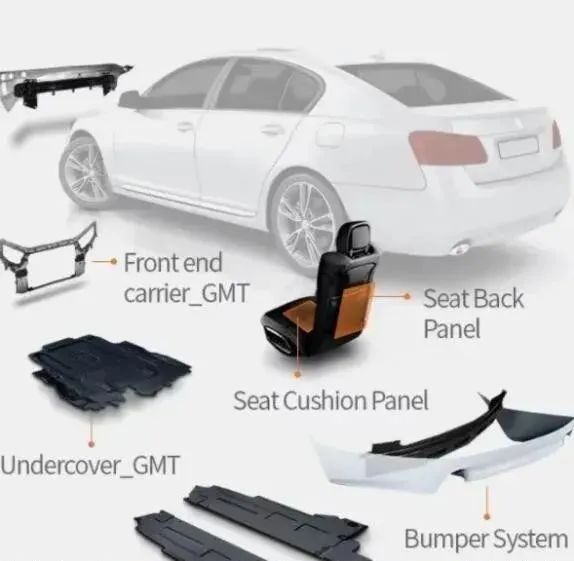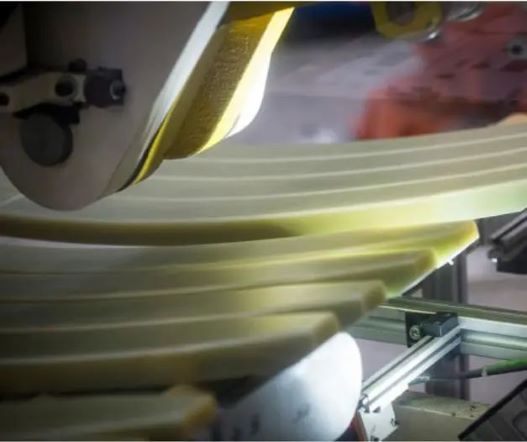Email: info@hdfiberglass.com Whatsapp: +86 15200033566
Views: 2 Author: Site Editor Publish Time: 2022-11-14 Origin: Site








Non-metallic materials used in automobiles include plastics, rubber, adhesive sealants, friction materials, fabrics, glass and other materials, involving petrochemical, light industry, textile, building materials and other related industrial sectors, so non-metallic materials are used in automobiles It reflects the comprehensive economic and technological strength, and also includes the technological development and application capabilities of a large number of related industries.
Glass fiber reinforced composite materials currently used in automobiles include: glass fiber reinforced thermoplastic (QFRTP), glass mat reinforced thermoplastic (GMT), sheet molding compound (SMC), resin transfer molding (RTM) and hand lay-up FRP products.
At present, the glass fiber reinforced plastics used in automobiles mainly include glass fiber reinforced PP, glass fiber reinforced PA66 or PA6, and a small amount of PBT and PPO materials.

Reinforced PP products have high rigidity and toughness, and their mechanical properties can be doubled or even improved. Reinforced PP is used in office furniture and other fields: such as children's back chairs, office chairs, etc.; it can also be used in axial fans and cross-flow fans in refrigeration machines such as refrigerators and air conditioners
Reinforced PA materials have been used in passenger cars and commercial vehicles, and are generally used to make some small functional parts, such as lock body guards, safety wedges, embedded nuts, accelerator pedals, shift upper and lower guards- Protective cover, opening handle, etc., if the quality of the material selected by the parts manufacturer is unstable, the production process is improperly used or the material is not dried well, the weak part of the product will break.

With the requirements of light weight and environmental protection in automobiles, the foreign automobile industry is more and more inclined to use GMT materials to meet the needs of structural components, mainly because GMT materials have good toughness, short molding cycle, high production efficiency, and low processing costs. , does not pollute the environment and a series of advantages, is regarded as one of the 21st century materials, mainly used in the production of passenger car multi-function brackets, instrument panel brackets, seat frames, engine guards, battery brackets, etc. FAW-Volkswagen currently The production Audi A6, and A4 cars have adopted GMT materials, but they have not achieved local production.
In order to improve the quality of the whole vehicle to catch up with the international advanced level and achieve the purpose of weight reduction, shock absorption and noise reduction, relevant domestic units have carried out research on the production of GMT materials and product molding processes, and have the ability to mass produce GMT materials, with an annual output of 3,000 A production line with tons of GMT material has been built in Jiangyin, Jiangsu Province, and domestic auto manufacturers have also adopted GMT material in the design of some models, and have started batch trial production.
Sheet molding compound (SMC) is an important glass fiber reinforced thermosetting plastic, which has been widely used in automobiles due to its excellent properties, mass production and A-grade surface. At present, there has been new progress in the application of foreign SMC materials in automobiles. At present, the largest application of SMC in automobiles is body panels, accounting for 70% of the amount of SMC, and structural parts and transmission parts are the fastest growing. In 5 years, the use of SMC in automobiles will continue to increase by 22% to 71%, while the growth in other industries is 13% to 35%.
Application status and development trend abroad
1. High-content glass fiber reinforced sheet molding compounds are increasingly used in automotive structural parts, and their application in structural parts was first demonstrated on two Ford models in 1995 (Ex-plorer and Ranger). , because it has a variety of functions, it is widely considered to be very advantageous in structural design, so it is widely used in automobile instrument panels, steering gear, radiator systems and electronic device systems.
The upper bracket and lower bracket molded by Budd Company in the United States are made of unsaturated polyester composite material containing 40% glass fiber. The two-piece front-end structural car meets the needs of users. The front end is low and the cab is forward, and the upper bracket is fixed at the front end. The headliner and front end are structurally upper, while the lower brackets cooperate with the cooling system. The two brackets are connected to each other and are combined with the canopy and the body structure to stabilize the front end.
2. Application of low-density SMC material The specific gravity of low-density SMC is 1.3, which is 30% lighter than standard SMC in practical applications and tests, and the specific gravity of standard SMC is 1.9. Using this low-density SMC can reduce weight by approximately 45% compared to comparable parts made of steel. All GM Corvette 99s use low-density SMC for the interior panels and new roof trim. There are also doors, hoods, trunk lids, etc.
3. Other applications In addition to the above-mentioned new uses, the application of SMC in automobiles is also used to produce other parts. Such as: cab doors, inflatable roofs, bumper skeletons, cargo doors, sun visors, body panels, roof drains, carport side bars, truck boxes, etc., of which the largest amount is used for body outer panels. Domestic application overview With the introduction of domestic passenger car production technology, it was first used in passenger cars, mainly used in spare tire wells and bumper frames, etc., and is also used in commercial vehicles, such as lifter chamber covers, expansion water tanks , Linear speed clamps, large/small partitions, air intake hood assemblies, etc.

The RTM method is to press resin into a closed mold with glass fiber, and cure at room temperature or heat. Compared with the SMC method, the RTM method has simple production equipment, low mold cost, and excellent physical properties of the product, but it is only suitable for small and medium-scale production. It is reported that the auto parts produced by the RTM molding method in foreign countries have been extended to the whole body panels. The domestic use of RTM molding technology to manufacture auto parts is still in the development stage, and the mechanical properties of raw materials, curing time, finished parts and other indicators strive to reach the production level of similar foreign products. At present, the auto parts developed and researched by the domestic RTM molding method include windshield, rear tailgate, air shroud, ceiling, bumper and rear liftgate of Fukang car.
However, how to make the RTM process faster and better applied to automobiles, the requirements of materials for product structure, the level of material performance, the evaluation criteria, the realization of A-level surfaces, etc., are the concerns of our automobile industry, as well as RTM The preconditions that can really be promoted in auto parts.
Why use glass fiber reinforced plastic (FRP)
From an automaker's point of view, FRP is an attractive alternative material compared to other materials, such as SMC/BMC:
save weight
component integration
freedom of design
much less investment
Making all-in-one antenna systems a reality
Dimensionally stable (low coefficient of linear thermal expansion, comparable to steel)
High mechanical properties at elevated temperatures
Compatible with E-coat (electronic coating)
Is it better to choose emulsion or powder for glass fiber chopped strand mat?
Building Stronger Ships: Application Cases And Technical Advantages of Yuniu Chopped Glass Fiber Mat
Yuniu Fiberglass Chopped Strand Mat - Helping Your Project To Success
Corporate Visual Identity of Hebei HaiDing Fiberglass Manufacturing Co., Ltd.
What does the price increase of fiberglass products (chopped strand mat) mean?
Fiberglass Materials for Electrical Insulation and Electronics Applications